Summary of today’s show: On a day without much news from the College of Cardinals, Scot Landry took the opportunity to take part of the Station Church tradition and visit the Basilica of Ss. Cosmas and Damian for Mass and then to interview Worcester seminarian Donato Infante, Fr. Norman Tanner, SJ, and Br. Mark McBride, TOR, in which he learned about the twin doctors to whom the church is dedicated and the fact that Masses have been celebrated there every day since 525AD. Then Scot spoke to Terry Donilon, Cardinal Seán’s spokesman, about how the media is covering the interregnum and especially letting the world get to know Cardinal Seán. And finally, he talks to a group of pilgrims from St. John’s Seminary’s Master of Arts in Ministry program who are following in the footsteps of Pope John Paul II from Poland to Italy.
Listen to the show:
Podcast: Play in new window | Download
Watch the show via live video streaming or a recording later: BostonCatholicLive.com
Today’s host(s): Scot Landry
Today’s guest(s): Donato Infante, Fr. Norman Tanner, Br. Mark McBride, Terry Donilon, Fr. Chris O’Connor, Mary Jo Kriz, Aldona Lingertat, Beth Joyce
Links from today’s show:
Today’s topics: LIVE from Rome: Station Church of Ss. Cosmas and Damian; Seminarian and Priest; Cardinal Seán’s spokesman; Pilgrims from Boston
1st segment: Scot Landry welcomed everyone to the show. It’s been a slow news day thus far in Rome as the cardinals are in a silent period. So instead Scot participated in the ancient Roman tradition during Lent of visiting the station churches. This practice dates to the fourth century and involves visiting 40 different churches in Rome during the 40 days of Lent. Each morning priests and seminarians from the North American College lead English-speaking pilgrims in Rome to the station church for Mass at 7am. George and Scot met with a group of about 50 seminarians at 6:15am at the bottom on the Janiculum hill and made the 35 minute walk to the basilica of Sts. Cosmas and Damian. It’s next the Roman Forum.
The journey along the streets is silent by rule of the seminary. It’s moving to walk through the quiet streets of Rome at that hour and see most of the seminarians praying the Rosary. Today, there were about 40 concelebrating priests, 60 seminarians and 60 others in this small, but beautiful basilica, which was consecrated a church in the year 535. There has been a Mass there everyday since.
Then played of the sounds of chant from the Mass.
2nd segment: Scot was joined by seminarian from the Diocese of Worcester, Donato Infante. Donato said the tradition of the station churches began in the early centuries of Christianity where the Bishop of Rome visited each of the churches of his diocese during Lent. Sometime in history the tradition stopped in the 1970s, the North American College revived tradition and other colleges in the city started doing the same.
Scot noted that nobody spoke while walking from the NAC. Donato said the faculty explicitly encourages them to take the walk as a time to pray to make it a pilgrimage to the churches. Scot asked him what he likes about the station churches. Donato said many of the churches are beautiful and have the tombs of many of the saints in the Roman Canon of the Mass. To go to their tombs is a wonderful pilgrimage and a great way to celebrate Lent. Others who attend are priests on sabbatical at the Casa Santa Mariae and faculty and students at universities in Rome.
Scot asked if he has a favorite church. Donato said San Clemente is his favorite because of the mosaic in the apse that is very old. He said a quarter of the seminarians go more than a couple of times per week, most go occasionally and they all go on Ash Wednesday to Santa Sabina as that’s the required community Mass.
More music and prayer from the Mass is now played.
3rd segment: Scot now welcomed Fr. Norman Tanner, a professor at the Gregorian University from Great Britain. Scot asked about the number of churches in Rome and their significance. Fr. Tanner said it’s a very ancient custom and Rome has 40 ancient churches which are station churches. Fr. Tanner said the 7am Mass is a perfect time to get in before their first 8:30am Mass.
Scot asked about Saints Cosmas and Damian. He said they were martyrs of the early church and are mentioned in the 1st Eucharistic Prayer. They were both medical doctors and surgeons.
Scot asked about the Gregorian. Fr. Tanner said many of the NAC seminarians and newly ordained study there. It was founded in 1554, two years before the death of St. Ignatius and it’s been a work of the Society of Jesus. There are about 2,500 students from almost all countries of the world.
Fr. Tanner said as a church historian it’s a unique privilege to be in Rome. The history of the Church helps in the study for the priesthood to understand the Christians of the past, like Cosmas and Damian.
More prayer from the Mass.
4th segment: Scot welcomes Br. Mark McBride, who works at St. Cosmas and Damian Basilica. He asked him how today compared to the Sunday liturgies. Brother said it’s not a parish church and so serve tourists and those with devotion to Cosmas and Damian. This day in Lent is special for the church. It has special Masses, including a special Mass in the evening with their titular cardinal. They have had English, German, and French groups come in for Mass and then their principal Mass would be in the evening at which the relics of the saints would be exposed for veneration.
Scot said many people might not know much about those saints. Br. McBride said they were doctors in Syria and martyred in 313 AD. People who admired them had great devotion to them and built two major basilicas for them, one in Rome and one in Constantinople. When Constantinople fell, so did the church. So the one in Rome is the remaining sanctuary. The two were twin brothers and they received no money for their services. When questioned by the Romans why they didn’t charge for their services, they said they did it for the Lord and so were martyred. In later centuries, people came to the basilica to pray for cures from their ailments. People from the East still come, many from Russia, Hungary, Romania, Slovakia, and celebrate the Divine Liturgy in the crypt.
The church was a part of a former Roman library built in 77 AD. It was used that way until 525 when the library was given to Pope Felix who converted it to a church. Pope Gregory the Great in the 600s had a major devotion to the saints there and to the Madonna della Salute, Our Lady of Good Health, which is also in the church. Mass has been said in the church every day since 525. Only a few other churches can boast such longevity.
Scot said the relics of Ss. Cosmas and Damian are in the lower church. Br. McBride noted that the lower church or Crypt Church was not the lower level at first, but was ground level in the 6th century. In the 1600s, the basilica was cut horizontally which made it two churches. The lower church contained the relics of the saints as brought back to Rome by Pope Gregory.
Scot said Br. McBride is originally from the San Francisco area. He asked him what led him to become a Franciscan and how did he come to Rome. Br. McBride said as a child he had a great devotion to the Franciscans, especially after studying the life of St. Francis. The pastor of his parish spoke of the TOR, Third Order Regular, Franciscans and he sought them out. He is not a priest, but a consecrated religious. From there he worked in their high school in the Philadelphia archdiocese for 20 years, then worked as provincial treasurer in the United States. From there he became general treasurer of the whole order which is headquartered at Ss. Cosmas and Damian.
Since coming to Rome, he has been made superior of the friary which has friars from around the world. He said many Americans will know the TORs because they sponsor Franciscan University of Steubenville in Ohio and St. Francis College in Loreto, Pennsylvania. They also have parishes in Florida and Texas.
Living in Rome is at times it’s an incredible feeling to the point it’s not even believable. To live at the church where St. Francis must have once prayed is incredible. The feeling of being in a room where millions of prayers have been offered is sometimes hard to even believe. You almost sense in the air that this is ancient. This is hard for Americans to grasp. The doorknobs of the church were made in 1400, centuries before America was founded. The choir stalls are from the 1600s. But because it looks so nice, it’s hard to imagine they’re so old. It makes him feel Catholic, a religion that knows no nationality, no single background.
Scot asked how being situated right by the Colosseum and Forum impact the number of visitors who come to the church or the experience of praying there. Fr. McBride said they are in the Ancient District of Rome, at the feet of the Palatine Hill. That’s where Rome was founded and became the center of the world for hundreds of years. Because it’s ancient and you can see the development of peoples from all the oldest periods of Rome, all blending together. To be there at the church, you are at the point of convergence of all those periods of time. In the church it’s the same, kneeling and praying in a place that goes back to a time before Christianity. When it was a library, it was a place dedicated to medicine and there is a sense of continuity, a sense of ever-old, ever-young. Today, they’re looking at making the basilica a center for bioethics to continue that idea.
Scot asked Br. McBride’s perspective on the papal transition today. He said the ancient basilica reminds us that this isn’t the first conclave. He describes this moment as a time of grace. Christ has promised us a Church. We believe what the cardinals are doing is no accident. We believe whoever the cardinals choose will be the successor of Peter. The Church isn’t a museum. It lives and renews itself, renews itself with a new leader.
Br. McBride said they don’t have favorites in the conclave, but they would of course love to see a Franciscan pope. They’re waiting to see how the Holy Spirit works through the choice that is made. The new Pope is elected for a reason. He compared the interregnum to Lent and awaiting Easter.
More prayer from the Mass.
5th segment: Scot Landry, reporting now from the Borgo Pio near the Vatican, welcomes Terry Donilon, spokesman for the Archdiocese of Boston, to the show. Scot asked Terry what Rome is like now in this anticipation.
Terry said it feels like a celebration waiting to happen. There have been long lines waiting to get into St. Peter’s, people milling about in the Square, attending the Holy Hour last night with the cardinals. He gets a sense that people are in an anticipatory state.
Scot noted Cardinal Seán did a lot of media interviews earlier this week and the American cardinals gained praise from around the world for their transparency. But as of yesterday there won’t be further press conferences as the cardinals decided not to speak. He asked Terry what the cardinal’s key themes were. Terry said the cardinal felt it would be good to take the time in the Congregations to assess the other cardinals so when conclave began he knew who he would vote for. The cardinal was very aware of the immense decision he and the other cardinals would be about to make. The cardinal is in a deep prayerful state right now to prepare for that.
Scot said more than 5,000 journalists have already been credentialed, including most from Boston. Why are they coming? Terry said Boston is a heavily Catholic community and the local news recognizes that this is important to the 1.8 million Catholics in the archdiocese. It’s an opportunity to see this rare transition in the Church. All the major networks and affiliates and newspapers are present and have invaded Rome.
Scot said many in the media were complimenting the American cardinals on how they were more open about process and other items they could talk about. That seems to be different from the culture of the Church in the rest of the world. Terry said the US Church believes in transparency. The cardinal finds an opportunity to talk to the people back in Boston. The rest of the world is slow to pick up on that.
He also noted that the rest of the Church in the world hasn’t reached the same level of the use of digital media and technology. There isn’t a diocese in the world that brought the same level of expertise and assets to communicate back to the people in the archdiocese. The cardinal said before he left Boston that there is a responsibility to report back to the people what can be reported. It’s unfortunate that the level of communication has changed but there were reports in the Italian press that made a lot of people take pause, although it wasn’t anything that came from the American cardinals.
Scot asked Terry his impression of the city, things you might not see elsewhere. Scot noted that the city rises late in the morning. He added that a lot of people come to visit St. Peter’s and it’s one of the best people-watching spots in the world. Terry said you see lots of priests and religious in great numbers walking the streets, seeing religious photos and items on display everywhere and clear signs that people are proud of their Catholic faith. He notes that many people speak English and he feels that more people speak English now than when he was in Rome in the late 90s.
Terry said the story is building toward the conclave. The media is analyzing the top contenders for pope, although the college of cardinals has a way of surprising us. He said he’s working to bring a Boston flair and focus top the coverage back home. It’s a major story and recognition of the pope’s influence on world affairs.
Scot said the three main questions he gets from people when they know he’s from Boston are:
- When’s the conclave going to start?
- Who does he think the next pope will be?
- Does Cardinal Seán have a chance?
What other questions are Terry getting? Terry said people want to know who Cardinal Seán really is. He’s given the world a glimpse of who he really is. In Boston, he’s well known, but the outside world is getting a glimpse of him and of the Archdiocese of Boston. Terry thinks the world is getting a chance to celebrate the hard work that has been done in Boston by the priests, religious, and laity of the archdiocese. People think Cardinal Seán is interesting because he stands out from the other cardinals and has had an influence through his work in the sexual abuse crisis but also his emphasis on the New Evangelization.
Terry said no one realistically thinks Cardinal Seán will be elected despite his qualifications and when he returns home after being celebrated so much, it will be a little surreal. At the worst, it opens the eyes of the world that the cardinals and bishops in America are doing good work on behalf of the Church and may open the door for a future American cardinal being elected pope.
6th segment: Scot, reporting from outside St. Peter’s Square, welcomed a pilgrimage group from the Master of Arts in Ministry program at St. John’s Seminary, including Fr. Chris O’Connor, Mary Jo Kriz, and Beth Joyce. He asked Mary Jo about the first part of their trip in Poland and what people should see on a pilgrimage there. She said Our Lady of Czestochowa was great but everything there, especially the people whose faith shines through in their daily life. The Divine Mercy chapel was perhaps the best.
Scot noted they are tracing the footsteps of Pope John Paul II. He asked Fr. Chris where else they have visited. Fr. Chris said they went to Auschwitz, where even there they saw a glimmer of hope in the tomb of St. Maximilian Kolbe. You feel John Paul’s presence in the city of Krakow, where he was born. He said there are more than 6,000 public statues of John Paul throughout Poland. You can feel his presence in that country.
Scot asked Beth about the great faith of the people of Poland under oppression. He asked her about these salt mines in which the people had carved cavernous churches underground complete with altars and statues.
Beth said the common people went down deep in to the earth to carve these beautiful reminders of our Lord. She said it shows the faith that permeates Poland.
Scot asked Aldona Lingertat about their itinerary in Rome for the days that they are there. She said today they were going on a walking tour of Rome, including Mass in St. Peter’s. They walked throughout the basilica and in the afternoon for the Scavi tour. The next day they were to go to Assisi, ending with Vespers in the chapel of San Damiano. On Friday, they were to visit the basilicas and more of the city, plus Mass at the tomb of Pope John Paul II. She’s been to Rome three times. Her favorite part is being steeped in the faith all around her in Rome.
Scot noted that it’s Beth’s third trip to Rome, but the first time since her son started studying at the North American College. He asked her how it’s different this time. She said came at Christmas to see her son and it’s a great blessing that he’s studying in Rome for the priesthood.
Scot said Cardinal Seán says that vocations are everyone’s business. He asked Beth what she did in her household that helped plant the seed for her son Kevin. When she realized her faith is a gift, she wanted to share it and wanted to communicate it to her child. She said the lives of the saints are great to share with them from a very early age because they were real people and they made it look possible to follow Jesus.
Scot noted that originally the pilgrimage was to be at the General Audience, so he asked Aldona what it was like to be in Rome during the sede vacante. Aldona said the Vatican Post Office issues a special stamp during the sede vacante and she bought some for herself. These will be very rare. She was interviewed by Italian TV when she bought them. It’s a unique moment in time and the Holy Spirit is at work.
She said her hope is that the new pope will be holy, prayerful and humble like our two previous popes. Also someone who is strong and courageous.
Scot asked Fr. Chris what he hopes people take away from these pilgrimages to Rome. He said the long tradition and history of preaching the Gospel and proclaiming Christ Jesus. There is a hopefulness in the sede vacante with the knowledge of the continuity of the Church.


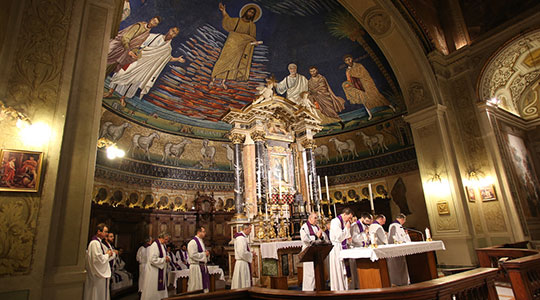

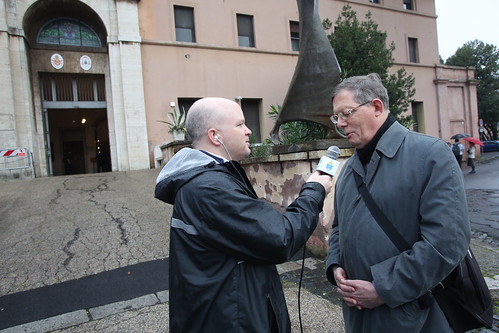


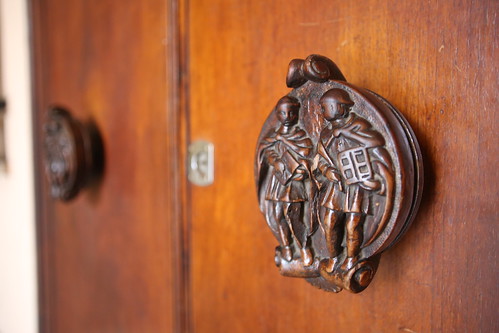
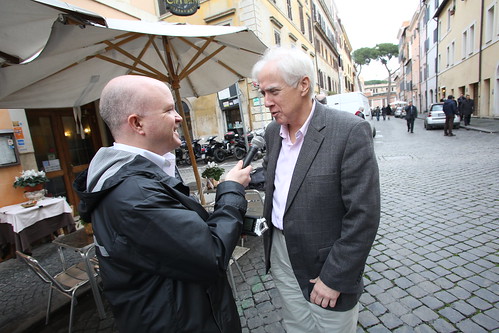
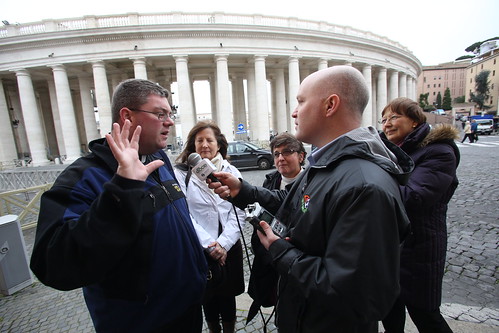

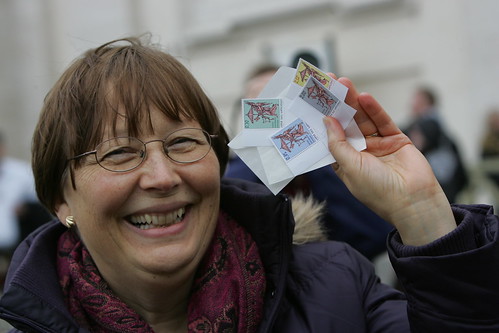

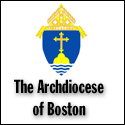



Comments Closed